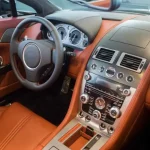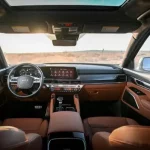In today’s automotive landscape, technology has transformed nearly every aspect of our vehicles, and car interiors are no exception.
Modern car interiors have evolved from simple cabins to sophisticated, tech-laden spaces that prioritize connectivity, safety, comfort, and convenience. In this article, we’ll explore the profound impact of technology on modern car interiors.
1. Infotainment Systems: The Digital Heart of the Cabin
One of the most visible and transformative aspects of modern car interiors is the introduction of advanced infotainment systems. These digital interfaces, often displayed on large touchscreen panels, serve as the central hub for entertainment, navigation, communication, and more. Features like Apple CarPlay and Android Auto seamlessly integrate smartphones, enabling drivers to access their favorite apps, music, and navigation services on the car’s display.
**2. Connectivity: Staying Linked to the World**
Connectivity is a defining feature of modern car interiors. With in-car Wi-Fi, Bluetooth, and advanced smartphone integration, occupants can stay connected to the internet, make hands-free calls, send messages, and stream content. Passengers can work, play, and communicate on the go, turning the car into a mobile extension of their digital lives.
**3. Voice Recognition: A Hands-Free Approach**
Voice recognition technology has become increasingly sophisticated and is now integrated into many modern car interiors. Drivers and passengers can control various functions using voice commands, from adjusting the climate to making phone calls. This hands-free approach enhances safety by minimizing distractions and allowing drivers to keep their focus on the road.
**4. Advanced Driver Assistance Systems (ADAS): Safety at the Forefront**
Technology has also significantly improved safety within car interiors. ADAS features like adaptive cruise control, lane-keeping assist, blind-spot monitoring, and automatic emergency braking provide an additional layer of protection. Some systems can even detect driver drowsiness and intervene when necessary, making driving safer for all.
**5. Customizable Digital Cockpits: Personalized Driving Experiences**
Digital instrument clusters and customizable digital cockpits have revolutionized how drivers interact with their vehicles. These high-resolution displays provide real-time information and can be tailored to suit individual preferences. Drivers can choose from various display modes, including navigation maps, performance data, and driver assistance visuals.
**6. Augmented Reality (AR): Enhancing Navigation**
Augmented reality (AR) navigation systems have started to emerge in modern car interiors. These systems overlay real-time navigation information onto the windshield, providing drivers with a clearer view of directions and important details. AR technology enhances situational awareness, making it easier to navigate unfamiliar routes.
**7. Gesture Control: Intuitive Interactions**
Some luxury cars now feature gesture control technology, allowing drivers and passengers to interact with the infotainment system through hand gestures. This intuitive method of control enhances user experience and reduces the need to touch physical buttons or screens.
**8. Ambient Lighting: Setting the Mood**
Ambient lighting has become a staple in modern car interiors, providing both functional and aesthetic benefits. It can be customized to create different lighting profiles, enhancing the mood and ambiance inside the cabin. Ambient lighting can also serve a practical purpose by highlighting important information or alerts.
**9. Climate Control Advancements: Perfect Comfort**
Advanced climate control systems use technology to ensure optimal comfort for all occupants. These systems offer precise temperature control, individualized climate zones, and even air purification features. Some vehicles also feature heated and ventilated seats that can be controlled through infotainment systems.
**10. Sustainable Materials: An Eco-Friendly Approach**
Technology has influenced not only the features but also the materials used in modern car interiors. There is a growing emphasis on eco-friendly, sustainable materials like recycled plastics, organic fabrics, and renewable resources. This shift aligns with the broader trend toward environmentally conscious design and manufacturing.
**Conclusion: The Technological Revolution Continues**
Technology has undeniably revolutionized modern car interiors, enhancing the driving experience in countless ways. As technology continues to advance, we can expect even more innovations that prioritize safety, connectivity, comfort, and sustainability. The integration of technology into car interiors reflects the ongoing commitment of automakers to meet the evolving needs and expectations of today’s drivers and passengers. The journey toward the future of automotive interiors is one that promises greater convenience, connectivity, and safety for all.


